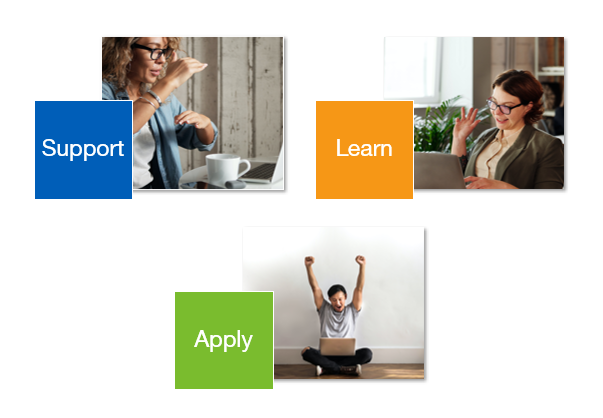
Once upon a time, in a land not too far away (Los Angeles, CA), I once engaged in, planned and facilitated, and tried to stay awake through quite a few professional development sessions. Most were mandated and scheduled right before school started in the hopes that something would transform our practice so much that 100% of our students mastered all learning objectives in 180 instructional days. After a few weeks of school, many of us were overwhelmed and discouraged that all of those awesome strategies and techniques didn’t work with every situation, every subject, or every student. I do not envy district and school administrators tasked with the responsibility of selecting and organizing PD each year.
Factors such as identifying teacher and student needs, finding resources and materials to meet those needs, and allocating budget can be quite stressful. Throw in the strong possibility that PD may be facilitated wholly online, and administrators must carefully wade through the glut of courses and programs available. Ultimately, the goal of any teacher PD is that students benefit from the implementation of new instructional strategies regardless of the learning environment (physical or virtual). How can administrators sort through the options available?
Let’s start with recognizing what makes PD effective:
- focus on content that includes strategies for using specialized curriculum or instructional tools within classroom contexts and provide multiple access points for students in all subject areas.
- active learning and practice opportunities to better understand the needs of diverse learners, including the why’s and how’s of engaging and collaborative learning for all.
- expert coaching and support that focuses on the teacher’s needs to nurture the diverse learners in their classrooms.
Then there are elements of PD that are vital, influencing teacher confidence with implementation:
- administrator support when it comes to providing PD that teachers feel they need; this may mean administrators survey teachers or engage in small group discussions, defining skills teachers do not feel confident with. Teachers should feel that if they make a mistake, administrators are there to support and guide. Better yet, administrators can offer to facilitate a lesson using skills and methods shared in a PD.
- peer collaboration that includes planning units/lessons together and engaging in peer observation. With many districts maintaining distance teaching for the rest of the year, opportunities for peer observation are more likely since “class coverage” is not an issue and teachers can freely take notes, and with permission, record and view learning sessions later. This type of peer collaboration should be taken advantage of while it’s still possible.
- personalized options to meet teacher needs where they currently are in their instructional experience, giving teachers time to process and apply new skills and methods. This does not necessarily mean that number of years in teaching is the same as experience with specific skills. For example, not everyone is comfortable with technology or using web applications. This takes time and patience is key.
- expert coaching and support. Yes, this was mentioned previously in what makes PD effective, but it is also vital with helping teachers feel confident with newly learned skills, to the point that they are willing to move beyond learned skills to discover and practice new skills. Some teachers may reach the level of confidence to innovate practice and serve as a coach to their colleagues.
Within the past few months, teachers have been thrust into distance teaching situations, usually with limited experience or comfort. Administrators at every level have had to quickly accommodate student learning needs, as well as the means for that learning to be delivered, which meant “fast track” professional development for teachers to learn the software and applications provided. It was almost like teaching someone to surf by plopping them in the middle of the ocean then pushing a surfboard towards them.
Yet, there are many stories swirling the Internet about schools and districts that have been able to successfully implement distance teaching tools. How? --with the guidance of companies in which effective professional development is a tenet of their overall mission to support educators. For example, Boxlight-EOS played a part in the Clayton County Public Schools (Jonesboro, GA) program, “Extending Learning Beyond the Classroom,” by helping them get up and running with distance teaching and learning. Their Director of Instructional Technology, April Mayo, Ed.S, described Boxlight-EOS’s efforts to help their district:
Boxlight-EOS completely transformed their normal on-site, digital classroom support to "Extending Learning Beyond the Classroom" coaching. The Boxlight-EOS team immediately created a schedule for multiple online training sessions (webinars and virtual playgrounds), a self-paced G Suite course, and provided on-demand virtual support; all in an effort to successfully "Extend Learning Beyond the Classroom".
Ms. Mayo went on to say, “During the first two months of providing teachers virtual support, we had over 3,500 instances of participation.” It is clear that when teachers feel PD is applicable, moves at their pace – whatever that pace may be--and provides ongoing and personalized support, comfort and self-confidence builds so that applying new skills becomes a natural component of the learning process.
As we get closer to wrapping up the school year and wonder, “What’s next?”, keep in mind the new opportunities available to educators with distance teaching and learning. Classrooms might look very different in September and administrators need insight to adequately prepare. Implementing quality PD will help teachers improve their practice so that, ultimately, students benefit from the new instructional strategies, regardless of the learning environment (physical or virtual).
To learn more about how Boxlight-EOS provides personalized professional development that can help teachers and students, please visit the link: Distance and Blended Learning Courses. You can also send questions to dte@boxlight.com


